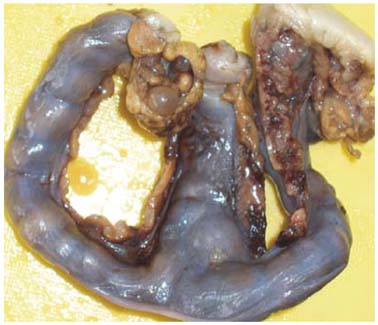J Vet Sci.
2006 Mar;7(1):87-88. 10.4142/jvs.2006.7.1.87.
A hermaphrodite dog with bilateral ovotestes and pyometra
- Affiliations
-
- 1NY Animal Hospital, Anyang 431-065, Korea.
- 2Animal Disease Research Unit, College of Life Science and Natural Resources, Wonkwang University, Iksan 570-749, Korea. kimoj@wonkwang.ac.kr
- 3Institute of Life Science and Natural Resources, College of Life Science and Natural Resources, Wonkwang University, Iksan 570-749, Korea.
- KMID: 1103561
- DOI: http://doi.org/10.4142/jvs.2006.7.1.87
Abstract
- Hermaphroditism was identified in a 3-year-old American Cocker spaniel with an enlarged os clitoridis that was shown as reddish finger-like structure protruding from the vulva. The urethral orifice was located cranially to the base of the os clitoridis. The gonads were situated caudal to the kidneys at the cranial tips of the uterine horns, and were composed mainly of seminiferous tubules and interstitial cells and had ovarian follicles in the cortices. The uterus was enlarged and revealed pyometra. Gross and histopathological findings of the dog suggested hermaphroditism with bilateral ovotestes and pyometra.
Keyword
MeSH Terms
Figure
Reference
-
1. Dain AR. Intersexuality in a Cocker spaniel dog. J Reprod Fertil. 1974. 39:365–371.
Article2. Hubler M, Huaser B, Meyer-Wallen VN, Arnold S. SRY-negative XX true hermaphrodite in a Basset hound. Theriogenology. 1999. 51:1391–1403.
Article3. Meyers-Wallen VN, Patterson DF. Kirk RW, editor. Disorders of sexual development in dogs and cats. Current Veterinary Therapy X. 1989. Philadelphia: Saunders;1261–1269.4. Meyers-Wallen VN. Genetics of sexual differentiation and anomalities in dogs and cats. J Reprod Fertil Suppl. 1993. 47:441–452.5. Meyers-Wallen VN. Kirk RW, Bonagura JD, editors. CVT Update: Inherited Disorders of the Reproductive Tract in Dogs and Cats. Current Veterinary Therapy XIII. 2000. Philadelphia: Saunders;904–909.6. Pailhoux E, Parma P, Sundstrom J, Vigier B, Servel N, Kuopia T, Locatelli A, Pelliniemi LJ, Cotinot C. Time course of femal-to-male sex reversal in 38, XX fetal and postnatal pigs. Dev Dyn. 2001. 222:328–340.
Article7. Selden JR, Moorhead PS, Koo GC, Wachtel SS, Haskins ME, Patterson DF. Inherited XX sex reversal in the Cocker spaniel dog. Hum Genet. 1984. 67:62–69.
Article8. Stewart RW, Meniges RW, Selby LA, Rhades JD, Crenshaw DB. Canine intersexuality in a pug breeding kennel. Cornell Vet. 1972. 62:464–473.
- Full Text Links
- Actions
-
Cited
- CITED
-
- Close
- Share
- Similar articles
-
- Pneumoperitoneum Caused by the Spontaneous Perforation of a Pyometra in an 80-Year-Old Woman: A Case Report
- Spontaneous uterine perforation due to pyometra presenting as acute abdomen in older age
- Sterile Pyometra in Two Dogs
- Pus leakage into abdominal cavity through oviduct in a Siberian husky with pyometra
- Spontaneous Perforation of Pyometra Leading to Acute Abdomen



